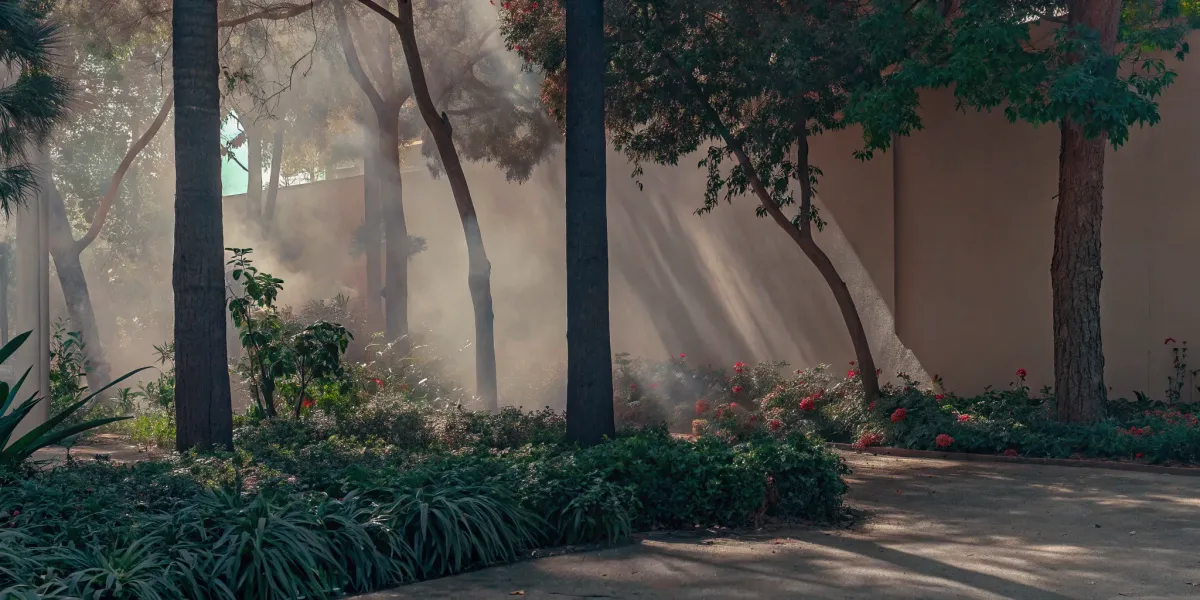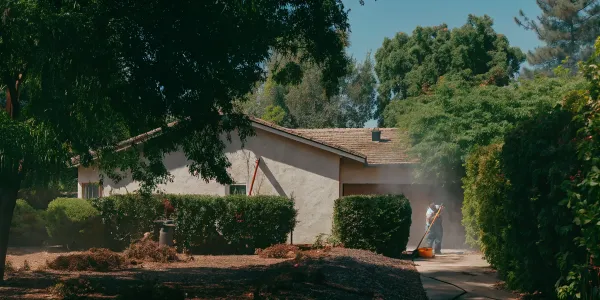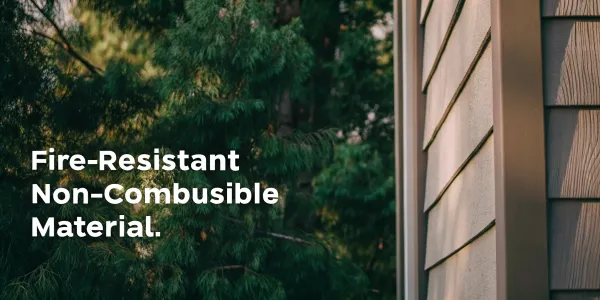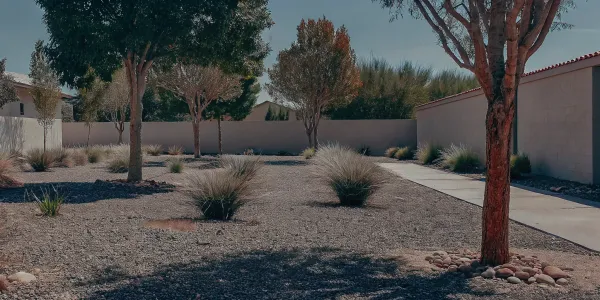The Ultimate List of Fire Resistant Plants and Trees
Find the best list of fire resistant plants and trees to protect your home, reduce wildfire risk, and create a safer, more resilient landscape.

Getting that non-renewal letter from your insurance company can feel like a punch to the gut. Suddenly, the home you love feels vulnerable, and the path forward is unclear. Many California homeowners are in the same boat, scrambling for solutions that go beyond just clearing brush. The truth is, what’s growing in your yard plays a huge role in how insurers see your property’s risk. This isn't just about aesthetics; it's about actively hardening your home against wildfire. By making smart choices, you can create a landscape that is both beautiful and a powerful line of defense. This guide provides a practical list of fire resistant plants and trees to help you build a defensible space that makes your home safer and more attractive to insurers.
Key Takeaways
- Maintenance Outweighs Plant Selection: A so-called "fire-resistant" plant becomes a liability without proper care. Your routine of watering, pruning dead material, and clearing debris is the single most important factor in creating a landscape that can actually defend your home from wildfire.
- Design Your Defense in Zones: Your yard isn't one space—it's a series of defensive rings. Start with a 5-foot non-combustible perimeter against your house, create a "lean, clean, and green" zone out to 30 feet by spacing plants, and reduce the overall fuel load in the area extending to 100 feet.
- Placement is as Critical as Plant Choice: Don't just pick the right plants—place them correctly. Use non-flammable walkways and rock features to break up vegetation, creating fire breaks instead of a continuous fuel path to your home, and group plants by water needs to keep them healthy and hydrated.
What Makes a Plant Fire-Resistant?
When you’re trying to protect your home from wildfire, your landscaping is your first line of defense. Choosing the right plants can make a huge difference in how your property stands up to embers and flames. But the term "fire-resistant" can be confusing. It doesn't mean a plant is fireproof—nothing is. Instead, it means the plant is less likely to ignite, and if it does catch fire, it won't significantly fuel the flames.
Think of it this way: some plants are like kindling, ready to burst into flames, while others are more like a damp log that smolders and burns slowly. Your goal is to fill your yard with the damp logs. Understanding what makes a plant a safer choice is the first step in creating a landscape that not only looks great but also gives you a critical advantage during a wildfire. This is a key part of building a defensible space that can help you stay insurable and protect your family.
Key Traits of Fire-Resistant Plants
So, what should you look for when you’re at the nursery? Fire-resistant plants share a few common characteristics. They generally have supple, moist leaves and a high water content, making them difficult to ignite. Their sap is typically watery and thin, not thick, sticky, or resinous like the flammable pitch found in pine trees. These safer plants also tend to have an open structure with less dense foliage, which means they don't accumulate a lot of dry, dead material inside. According to the Arbor Day Foundation, some trees even have thick bark that acts as a protective layer against heat. The bottom line is that fire-resistant plants don't offer a lot of fuel for a fire. They are clean, green, and lean.
Common Myths About "Fireproof" Landscaping
Let's clear up the biggest misconception right away: there are no "fireproof" plants. As organizations like Fire Safe Marin constantly remind homeowners, any plant will burn if it gets hot enough or isn't properly maintained. Even a yard full of succulents can become a fire hazard if it’s covered in dead leaves and dry weeds. The idea that you can plant a "fireproof" barrier and walk away is a dangerous myth. Your maintenance routine is just as important as your plant selection. A so-called fire-resistant shrub that is drought-stressed and full of dead branches can be just as dangerous as a highly flammable juniper. The key is to pair smart plant choices with consistent care—proper watering, pruning dead wood, and clearing away fallen leaves and debris. This proactive approach is what truly creates a fire-safe landscape.
Choose the Best Fire-Resistant Trees
Choosing the right trees is one of the most important steps you can take to create a fire-safe landscape. The goal isn’t to clear-cut your property, but to be strategic about what you plant and where. Fire-resistant trees are less likely to ignite from embers and can help slow the spread of a wildfire, giving firefighters a better chance to defend your home. These trees typically have high moisture content in their leaves, minimal deadwood, and sap that is more watery than resinous. Think of them as living, breathing fire breaks. Making smart choices here can significantly lower your property’s overall risk and may even help you maintain your home insurance in a tough market.
It's a proactive measure that puts you in control, turning your yard from a potential liability into a line of defense. By carefully selecting species and managing their placement, you are actively hardening your home against wildfire threats. This isn't just about aesthetics; it's a critical component of your overall wildfire action plan. The right trees, properly maintained, can disrupt a fire's path, reduce the intensity of flames, and catch wind-blown embers before they reach your roof or vents. This section will walk you through the best trees to plant—and the ones to remove immediately—to build a more resilient property.
Top Large Deciduous Trees
It might seem counterintuitive, but some trees are naturally more resistant to fire. As the Arbor Day Foundation explains, certain species have features that help them survive wildfires. Large deciduous trees—the kind that drop their leaves in the fall—are often excellent choices. Their high moisture content and lack of flammable resins make them less likely to burn. Their open, airy canopies also prevent them from becoming dense fuel sources that can carry flames upward. Consider planting hardwoods like maple, poplar, or cherry trees at a safe distance from your home to create a beautiful and resilient first line of defense.
Recommended Medium-Sized Trees
For smaller yards or areas closer to your home (but still outside the 5-foot ember-free zone), medium-sized trees offer a great balance of beauty and safety. They provide shade and structure without creating a massive fuel load. According to wildfire safety experts, some of the most fire-resistant trees are hardy species that work well in a variety of climates.
A few excellent choices include:
- Common Hackberry
- Crabapple
- Pin Oak or Red Oak
- Rocky Mountain Maple
- Western Catalpa
These species are known for their lower flammability, making them a smart addition to a layered, fire-wise landscape design.
Best Ornamental and Native Options
Planting native species is one of the smartest moves you can make, especially in California. Native plants are already adapted to the local climate, meaning they often require less water and are naturally more resilient to regional conditions, including fire. Incorporating these not only supports the local ecosystem but also strengthens your defensible space. Great examples of fire-resistant native plants for California include the majestic Coast Live Oak, the California Sycamore, and the vibrant Toyon. These plants can add beauty and character to your property while serving as a critical part of your home’s wildfire protection plan.
Trees to Avoid in High-Risk Fire Zones
Just as important as knowing what to plant is knowing what to remove. Certain trees are like kindling waiting for a spark. These species often contain flammable oils, shed dry leaves and bark, and have dense foliage that can easily carry fire straight to your home. If you have any of these on your property, especially close to structures, you should prioritize their removal. Experts point to invasive and highly flammable plants like Eucalyptus, which is notoriously oily and explosive in a fire. Other trees to remove from high-risk zones include Edible Fig, False Sandalwood, and Pepper Trees. Clearing these species is a non-negotiable step in creating a safer property.
Select the Right Fire-Resistant Plants
Choosing the right plants for your landscape is one of the most effective steps you can take to protect your home. Fire-resistant plants are not fireproof, but they are less likely to ignite and can slow the spread of flames. These plants typically have supple, moist leaves and a low sap or resin content. By strategically placing them around your property, you can create a landscape that is both beautiful and a key part of your home’s defense system. Making smart plant choices is a proactive way to reduce your wildfire risk and give yourself more peace of mind.
Fire-Safe Ground Covers
Ground covers are your first line of defense on the soil level. The best choices form a dense mat that helps retain moisture in the soil and prevents flammable weeds from taking over. Look for ground covers with thick, fleshy leaves that hold a lot of water, making them naturally less combustible. Plants like sedum and ice plant (Delosperma) are excellent options because they stay low to the ground and can handle dry conditions without becoming a fire hazard. Replacing a dry, grassy patch with a lush, water-filled ground cover is a simple swap that can significantly improve your property’s resilience.
Resilient Flowering Perennials
A fire-safe garden doesn’t have to be a barren one. You can add vibrant color and texture with carefully selected flowering perennials. Many beautiful flowers are also surprisingly tough and fire-resistant. Plants like Coneflower (Echinacea), Daylily (Hemerocallis), and Lavender are great choices because they have low fuel volume and don’t accumulate a lot of dead, dry material. Yarrow (Achillea) is another hardy perennial that thrives in sunny, dry spots. When selecting plants, prioritize those that are well-suited to your climate to ensure they stay healthy and hydrated with minimal effort. You can find an extensive list of fire-resistant plants to help you plan your garden beds.
Hardy Succulents and Desert Plants
For homeowners in dry climates, succulents are a fantastic landscaping tool. Their defining feature—thick, fleshy leaves that store water—makes them exceptionally fire-resistant. Because they hold so much moisture, they are difficult to ignite and can act as a barrier to slow down a ground fire. Varieties like aloe and agave are not only structurally interesting but also require very little maintenance once established. Planting succulents in the zone closest to your home, especially in rock beds or planters, can create an effective, non-combustible buffer that helps keep embers from finding fuel near your foundation.
Why Native Plants Are a Smart Choice
Choosing plants native to your region is one of the smartest moves you can make for a fire-safe landscape. Native plants are already adapted to your local climate and soil conditions, which means they generally require less water and fertilizer to thrive. A healthy, well-hydrated plant is always less flammable than a stressed, dry one. Beyond fire safety, native plants also support local ecosystems by providing food and shelter for birds, bees, and butterflies. Incorporating them into your garden creates a sustainable defensible space that is both resilient and environmentally beneficial.
Flammable Plants to Remove Immediately
Just as important as adding the right plants is removing the wrong ones. Certain plants are notoriously flammable and can act like gasoline in a wildfire. Trees like Eucalyptus and some pines are filled with volatile oils and resins that can burn explosively. Invasive species like Broom and Black Mustard should also be removed immediately, as they spread quickly and create dense fields of fine, dry fuel that can carry fire with incredible speed. Take a walk around your property and identify these high-risk plants. Removing them, especially within the first 30 feet of your home, is a critical step in protecting your property.
Design a Fire-Safe Landscape
Creating a fire-safe landscape isn’t about clearing your entire property down to the dirt. It’s about smart, strategic design that creates a buffer between your home and a wildfire. This buffer is often called “defensible space,” and it’s your home’s first line of defense. By thinking of your yard in terms of zones, you can systematically reduce flammable materials where they pose the greatest threat. This approach not only makes your property safer but can also be a key factor for insurers when they assess your home’s risk. A well-designed landscape gives firefighters a safer space to work and can significantly improve your home’s chances of survival.
Zone 1: The Ember-Resistant Zone (0-5 feet)
Think of the first five feet from your foundation as a non-combustible zone. This is the most critical area because it’s where wind-blown embers land and can ignite your home. Remove all flammable materials here. That means no bark mulch, no dry grasses, and no flammable plants right up against the house. Instead, use materials like gravel, pavers, or concrete. If you want plants, choose high-moisture options like succulents and place them sparingly. Keep this area completely free of dead leaves, pine needles, and firewood stacks. This simple, clean perimeter is one of the most effective home hardening steps you can take.
Zone 2: The Lean, Clean, and Green Zone (5-30 feet)
This next ring of defense is all about interrupting a fire’s path. Your goal here is to keep the landscape “lean, clean, and green.” Lean means creating space between plants to stop fire from jumping from one to the next. Clean means diligently removing dead branches, dry leaves, and other yard waste that acts as kindling. Green means keeping your plants healthy and well-watered, as hydrated plants are less likely to burn. Arrange plants in small, separated clusters or “islands” surrounded by non-flammable walkways or rock features. This design breaks up the fuel and robs an approaching fire of momentum.
Zone 3: The Reduced Fuel Zone (30-100 feet)
In this outer zone, your focus shifts to reducing the overall fuel load. You don’t need to clear everything, but you should thin out dense vegetation. Remove dead trees and shrubs, and prune the lower branches of mature trees at least 6 to 10 feet from the ground to prevent a surface fire from climbing into the canopy. The goal is to slow a wildfire down and reduce its intensity before it gets close to your home. Using well-spaced, fire-resistant plants in this zone can make a huge difference in creating a safer environment around your property.
How to Place Plants Strategically
Plant placement is just as important as plant selection. A fire-resistant plant in the wrong spot can still become a hazard. The basic rule is simple: position plants that are more flammable farther away from your house. Trees and large shrubs should be planted outside of Zone 2, at least 30 feet away from your home. Within your landscape, avoid planting in dense, continuous rows that can act like a wick, pulling fire directly toward your structures. Instead, stagger your plantings and use hardscaping like patios and stone paths to create natural fire breaks throughout your yard.
Essential Spacing and Layout Rules
Proper spacing is crucial for preventing fire from spreading easily across your property. You need enough room between plants, both horizontally and vertically. This is especially important for stopping a “fire ladder,” where flames climb from low-lying grasses to shrubs and then up into tree canopies. On a sloped yard, you need to be even more careful, as fire travels much faster uphill. A good rule of thumb is to double the recommended spacing between plants on a moderate slope. For detailed guidelines tailored to your property, resources from organizations like Fire Safe Marin can provide specific measurements and advice.
Find the Right Plants for Your Region
Now that you know what makes a plant fire-resistant, the next step is choosing species that will actually thrive where you live. A fire-smart plant in the Sierra Nevada foothills might not be the best choice for a coastal property, and vice versa. The most resilient landscape is one that works with your local climate, not against it. Here’s a breakdown of what to look for in your specific region to create a beautiful yard that’s easier to defend.
For California and the West
Living in California means adapting to our dry climate, and your landscaping should do the same. The best defense is using plants that are naturally suited to it. When planning your garden, look for a mix of beautiful and resilient native species that won’t become a liability during fire season. Some solid choices include Toyon, California Sycamore, and Coast Live Oak for trees. For shrubs, consider Common Yarrow, Coyote Bush, or California Lilac. For a low-growing option, Wild Strawberry is a great groundcover. Just remember, even fire-resistant plants need care. Regular watering, pruning, and clearing of dead material is non-negotiable to keep them from becoming fuel.
For Mediterranean Climates
Many parts of the West share a Mediterranean climate—think hot, dry summers and mild, wet winters. If this sounds like your area, you’ll want to select plants with a few key traits. Look for plants with supple, moisture-rich leaves and avoid those with strong-smelling, waxy, or resinous foliage, as those oils can be highly flammable. Drought-tolerant plants are your best friends here, as they stay healthy without needing constant water. Finally, choose non-invasive species that won’t spread uncontrollably and create dense patches of fuel. These simple guidelines will help you create a landscape that is both beautiful and better prepared for wildfire.
For Mountain and Forest Homes
If your home is nestled in the mountains or a forest, your landscaping choices are critical. You're living in the wildland-urban interface, where a forest fire can quickly become a structural fire. When selecting trees, look for species with specific defensive traits. Trees with thick bark can better protect their living tissue from heat. Species with high moisture content in their leaves and wood will burn slower. Most importantly, choose trees that don't have low-hanging branches. This height helps prevent a ground fire from climbing into the canopy and creating a more intense and dangerous crown fire. Pruning lower branches on existing trees is just as important.
For Coastal Properties
Coastal properties have their own unique environment, but that doesn't mean fire risk is off the table. Strong winds can carry embers for miles. The good news is that many beautiful coastal plants are also fire-resistant. Look for options like Beardtongue (Penstemon), which is drought-tolerant and holds moisture in its leaves. Coneflower (Echinacea) is another great choice that thrives in dry soil and has low flammability. For something more compact, Coral Bells (Heuchera) reduces fuel density. Even the common Daylily is a smart pick, as its thick, grass-like leaves retain water well. These fire-resistant plants can add color and texture to your garden while making it a safer space.
Maintain Your Fire-Resistant Landscape
Choosing fire-resistant plants is a fantastic first step, but your work doesn’t end once they’re in the ground. A fire-safe landscape is a well-maintained one. Dry, dead, or overgrown vegetation can quickly become fuel for a wildfire, even if the plant species is considered fire-resistant. Regular upkeep is essential for keeping your defensible space effective and protecting your home. Think of it as an ongoing commitment to your property’s safety.
This maintenance isn’t just about yard work; it’s a critical part of your overall wildfire preparedness strategy. Insurers are increasingly looking for homeowners who actively manage their property’s risk. A clean, healthy landscape shows you’re serious about protection. By following a simple routine, you can ensure your plants stay healthy, hydrated, and ready to do their job: slowing the spread of fire and keeping embers at bay. Let’s walk through the key tasks to keep on your calendar.
Your Seasonal Maintenance Checklist
To keep your landscape in top fire-safe condition, you need a consistent routine. Throughout the year, focus on keeping plants healthy and removing potential fuel. To keep plants fire-resistant, you need to water them regularly, fertilize them as needed, and remove any dry, dead leaves or branches. Pruning shrubs and trees to create space between branches also helps reduce the risk of fire spreading from plant to plant. A well-maintained garden is less likely to carry fire toward your home.
Here’s a simple checklist to follow:
- Clear Debris: Regularly rake leaves, pine needles, and twigs from your yard, roof, and gutters.
- Prune Plants: Trim back any branches overhanging your roof or chimney.
- Remove Dead Material: Cut away dead or dying branches from trees and shrubs.
- Maintain Spacing: Ensure plants are properly spaced to prevent a continuous path for fire.
How to Prune and Clear Debris Safely
Properly pruning plants and clearing debris are two of the most effective things you can do to maintain your defensible space. The goal is to eliminate "ladder fuels"—low-hanging branches, shrubs, and dead material that can carry a ground fire up into the tree canopy or toward your home. You should regularly remove dry leaves, dead branches, and other flammable stuff from your garden. It’s especially important to cut off dead wood from trees and bushes, as this can easily fuel a fire.
When clearing, pay close attention to the area immediately around your house, especially within the first five feet. This zone should be free of flammable mulch, dead leaves, and overgrown vegetation. When you prune, focus on creating separation between plants and lifting tree canopies at least six to ten feet from the ground.
Smart Watering Strategies
A plant’s resistance to fire is directly tied to its moisture content. Even fire-resistant species can become flammable if they are dry and stressed. It’s crucial to keep your plants well-watered, especially during dry seasons and periods of high fire danger. Healthy, hydrated plants are less likely to ignite from flying embers and can help slow the advance of a wildfire.
Consider using smart irrigation methods to keep your landscape healthy without wasting water. Drip irrigation systems are an excellent choice because they deliver water directly to the plant’s roots, minimizing evaporation and runoff. Grouping plants with similar water needs together also makes watering more efficient. A deep, infrequent watering schedule is generally better than frequent, shallow watering, as it encourages deeper root growth and makes plants more resilient.
Can a Fire-Safe Landscape Help Your Insurance?
Yes, it absolutely can. While a fire-resistant landscape alone won’t guarantee you an insurance policy, it’s a critical piece of the puzzle that insurers are paying more attention to. Creating and maintaining defensible space is a tangible action that demonstrates you are actively reducing your property’s wildfire risk. Insurers want to see that homeowners are taking proactive steps, and a well-managed landscape is clear evidence of that.
Under regulations like California’s “Safer from Wildfires” framework, insurance companies are now required to factor mitigation efforts into their pricing. Using fire-resistant plants in your defensible space can help protect your home from wildfires and slow their spread, which may qualify you for mitigation discounts. Documenting your efforts—from plant selection to regular maintenance—is key. These steps are part of a larger strategy that makes your home a better risk, which is exactly what insurers want to see.
Group Plants for Maximum Safety
Choosing the right plants is a huge step, but how you arrange them in your yard is just as critical for fire safety. A well-designed landscape can actively slow the spread of flames and help protect your home, while a poorly planned one can create a direct path for fire. Think of your garden as a key part of your home’s defense system. The goal is to create a landscape that is difficult for fire to move through.
This means grouping plants thoughtfully, using them to create natural fire breaks, and ensuring they are well-suited to your local environment. By arranging plants based on their water needs, you keep them healthy and less flammable. By breaking up continuous vegetation with walkways or rock gardens, you rob an approaching fire of fuel. This strategic approach is fundamental to creating a truly fire-safe property and is a core component of a strong defensible space. It’s not about having a barren yard; it’s about smart, intentional design that works with nature to keep your family and property safe.
Group Plants by Water Needs
One of the most effective landscaping strategies is called hydrozoning. This simply means you group plants together that have similar water, sun, and soil needs. When you put thirsty plants next to those that prefer dry conditions, one group is always going to be stressed. Stressed, dry plants are highly flammable. By creating zones for high-water-use plants (like a vegetable garden) and low-water-use plants (like native succulents), you can water more efficiently and ensure everything stays healthy and hydrated. Healthy, moisture-rich plants are far less likely to ignite and can help slow a fire’s progress.
Use Plantings to Create Fire Breaks
Your landscape can either provide an uninterrupted path for fire to reach your home or create barriers that slow it down. Use plantings to intentionally create fire breaks. This involves breaking up large areas of vegetation with non-flammable materials like gravel paths, stone patios, or rock gardens. Avoid planting long, continuous rows of hedges or shrubs that can act like a fuse. Instead, plant in small, isolated clusters or islands. This layout forces a fire to cross a non-flammable area to find its next fuel source, giving firefighters a better chance to defend your home.
Adapt to Your Local Conditions
A plant that is struggling is a fire hazard. That’s why it’s so important to choose plants that are native to your area or well-adapted to your specific climate. Native plants have evolved to thrive in your local soil and weather conditions, making them more resilient to pests, diseases, and drought. As Fire Safe Marin notes, healthy plants that are well-suited to their environment are less likely to produce dead, dry material that can easily ignite. They require less maintenance and water, making them a smart, low-effort choice for a fire-safe yard.
Strengthen Your Defensible Space
All of these strategies come together to strengthen your defensible space—the buffer zone you create between your home and the surrounding wildland. This area, extending up to 100 feet or more from your house, is your first line of defense. Using properly grouped, well-maintained, fire-resistant plants within this zone is one of the most important actions you can take to protect your property. It’s a critical step that insurers look for and can make a real difference when a wildfire approaches. Putting these principles into practice is easier when you have a clear roadmap. You can create a tailored plan to assess your property’s unique risks and get actionable steps for your landscape.
Related Articles
- Protect Your Home: Top 10 Wildfire Prevention Measures
- How to Get CA Home Insurance in High Fire Risk Areas
- Wildfire Season: Why It's Now a Year-Round Threat
Frequently Asked Questions
Will creating a fire-safe landscape guarantee I can get or keep my home insurance? While there are no guarantees in the current insurance market, creating and maintaining a fire-safe landscape is one of the most powerful steps you can take. It shows insurers that you are actively reducing your property's risk, which makes you a much more attractive client. Under new regulations, many California insurers are required to offer discounts for wildfire mitigation efforts, and a well-designed defensible space is a key part of that. Think of it as building the strongest possible case for your home's insurability.
Do I have to tear out my entire yard and start over? Absolutely not. The idea of re-landscaping can feel overwhelming, but you don't have to do it all at once. Start by removing the most flammable plants, especially high-risk species like juniper, eucalyptus, or invasive broom, particularly within 30 feet of your home. From there, you can gradually work on creating proper spacing and establishing the defensible space zones. It's a process, not a weekend project.
What's the most critical area to focus on if I have a limited budget or time? Focus on the area immediately surrounding your foundation—the first five feet out from your house. This is the "ember-resistant zone," and it's your most important line of defense. Clear this area of all flammable materials, including bark mulch, dry grass, and flammable plants. Replace them with non-combustible options like gravel or pavers. Keeping this small perimeter clean is the single highest-impact action you can take to protect your home.
Are succulents completely fireproof since they hold so much water? This is a common myth. While succulents are exceptionally fire-resistant because of their high water content, nothing is truly fireproof. Their fleshy leaves are difficult to ignite and can slow down a ground fire. However, if your succulent patch is full of dead leaves and dry weeds, that debris can easily catch fire and burn hot enough to damage or destroy the plants. The key is pairing smart plant choices with consistent maintenance.
Can I still have a lawn, or is all grass a fire hazard? You can absolutely have a lawn, as long as you maintain it properly. A healthy, well-watered, and closely mown lawn can act as an excellent fire break because it has a high moisture content. The danger comes from dry, brown, or overgrown grass, which becomes fine fuel that can spread fire rapidly. If you choose to have a lawn, commit to keeping it green, short, and free of thatch.




